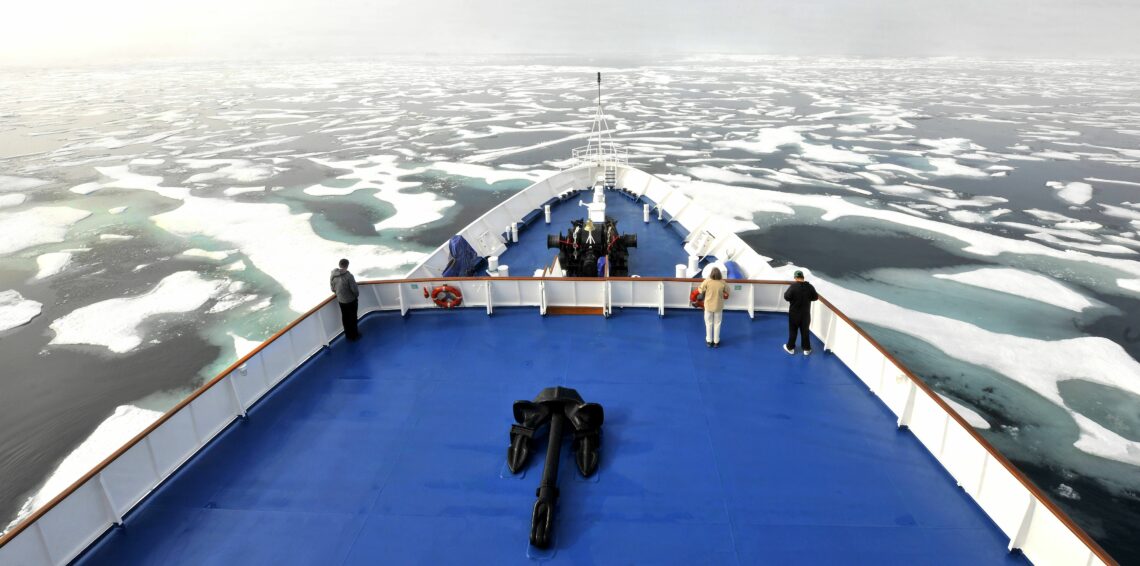Geopolitical power play in Arctic shipping
Rising earth temperatures have opened up new routes through the Arctic, allowing commercial ships to shorten journeys between Europe and Asia dramatically. While this could improve trade flows, territorial conflicts and legal uncertainty are causes for concern.

In a nutshell
- There is growing interest in Arctic shipping routes
- Rising military tension is becoming problematic
- The Arctic Council could offer a mediating platform
Weather changes have recently made the remote, inhospitable Arctic easier to navigate. While the area holds opportunities for trade and transport, particular geopolitical challenges will need to be overcome before the potential of the region can be put to good use.
New shipping routes
The two main sea routes through the Arctic are the Northeast Passage, which stretches across Eurasia, and the Northwest Passage, which follows the Canadian and American coasts. In the past, thick ice made navigation difficult but as the earth’s temperature rises, glaciers and ice sheets melting will open up new routes.
There is growing interest in making both the Northeast Passage and the Northwest Passage transit hubs between the Atlantic and the Pacific. Numerous commercial ships have made the voyage during the summer.
In 2014, Nunavik, a vessel owned by Fednav, a group of Canadian companies, became the first cargo ship to sail through the Northwest Passage without the aid of icebreakers. It transported nickel from Canada to China on a 26-day journey, decreasing transportation time by 15 days compared to the 41-day return through the Panama Canal.
In August 2018, shipping company A.P. Moller-Maersk sent the first container ship from East Asia to Europe via the Arctic through Russia’s Northern Sea Route (along the Northeast Passage). The Danish conglomerate found that a journey across the Arctic Ocean could reduce travel time by up to 40 percent compared to routes in southern Asia and through the Suez Canal or past the Cape of Good Hope in Africa. In the summer of 2019, the company announced it would explore the possibility of cooperating with Atomflot, a Russian operator of nuclear-powered icebreakers.
An optimization of Arctic routes could have a significant impact on the global economy.
In 2017, 32 vessels made the journey across the Arctic. However, these were mostly icebreakers and tankers, and commercial shipping is still rare in the region. Nevertheless, a 2019 paper from the U.S. Committee on Marine Transportation predicts that the number of vessels operating in the U.S. Arctic is likely to triple by 2030. Chinese Ocean Shipping Company (COSCO) is also planning to ramp up its use of the Northern Sea Route in years ahead.
With 90 percent of global trade transported by ships, an optimization of Arctic routes could have a significant impact on the global economy.
In recent years, the Suez Canal has been the prevailing choice for companies shipping goods to and from the East. As of early 2020, traffic in the Suez Canal was breaking records in numbers and tonnage of vessels transiting, as well as daily revenues in transit fees. Open routes in the Arctic would facilitate trade flows between Europe and Asia and also decrease traffic in the Suez Canal.
Travel through the Arctic also means less fuel, less CO2 emissions and fewer transit fees. Ships would no longer need to go through areas plagued by piracy, ultimately allowing for an overall increase in the amount of cargo being shipped worldwide.
Why, then, are shipping companies so cautious with Arctic activities? The answer comes down to geostrategic concerns.
Military presence
Currently, the Arctic is governed primarily through soft law by the Arctic Council, an international forum consisting of eight states: Canada, the Kingdom of Denmark (including Greenland and the Faroe Islands), Finland, Iceland, Norway, Russia, Sweden and the United States. The council’s purpose is to promote cooperation, coordination and interaction between Arctic states on issues like sustainable development and environmental protection. The area is also subject to the domestic laws of the eight states, which causes significant uncertainty.
During an Arctic Council meeting in Finland in May 2019, U.S. Secretary of State Mike Pompeo stated that the Arctic had become an arena of global geopolitical power and competition. During the Cold War, military bases were scattered on borders between NATO countries and the Soviet Union. At present, dormant tension is waiting to resurface. There has been an increase in military exercises by both NATO and Russia. The U.S. has been modernizing the Thule Air Force Base in Greenland, stepping up a major strategic asset. In the summer of 2019, U.S. President Donald Trump even considered purchasing Greenland from Denmark.
Russia, meanwhile, has been intensifying its aviation and naval activities, building 475 military sites in the Arctic over the past six years. In the last days of December 2019, it published a comprehensive infrastructure development plan for the Northern Sea Route. Moscow plans a 90 million-ton increase in maritime traffic by 2030. Both Russia and the U.S. have commissioned new icebreaker fleets, underlining their commitment to developing transit in the Arctic.
The military tension between the two nations is influencing the shipping sphere. In 2017, Russian authorities declared that 20 percent of all ships traveling the Northern Sea Route had violated its rules of navigation, thus justifying restrictions. This move angered Washington. It answered that all Arctic passages should be considered international waters.
Both Russia and the U.S. have commissioned new icebreaker fleets.
Today, Russia demands to be notified of any trip at least 45 days in advance and requires information on the ship and its route. Additionally, it stipulates that the ship must pay transit fees and take on a Russian pilot for the duration of the trip – conditions to which U.S. Navy ships, for example, are unlikely to agree.
In 2019, the U.S. threatened to have naval vessels transit the Arctic along the Russian coast in an operation named Freedom of Navigation. In April 2020, Russia activated a new defense unit along its Northern Sea Route. With both sides showing no intention of stepping down their engagement in the region, a military conflict is not impossible – although still unlikely at the moment.
This military posturing shows Washington’s eagerness to strike a new balance between coastal state jurisdiction and international navigational rights. The Arctic Council has not interfered so far, but if tension rises, the organization may have to weigh its options to prevent a potential conflict. According to a footnote in its founding declaration, the council “should not deal with matters of military security.” However, the declaration is not legally binding and could be altered if its members reach a consensus.
The council will seek ways to contain brewing military tensions. Arctic states have so far proven extremely reluctant to formalize the situation with legally binding treaties. Should military pressure continue to rise, the organization would likely try to offer a mediating platform to the conflicting parties instead.
Non-Arctic states
For Arctic shipping to gain traction, the option must become safe, reliable and efficient. The current infrastructure does not allow seamless shipping yet, which has sparked an investment race in the region. Finland, Norway and Denmark are considering significant developments within their respective Arctic zones. Ottawa is also planning to invest in the area, but the many islands and lack of deepwater ports on the Canadian coast make it less viable than Russia’s Northern Sea Route.
On March 5, 2020, Russia confirmed its own appetite for infrastructure when it published a decree setting out a road map for multimillion investments and the massive industrialization in the Arctic by 2035. Moscow is planning to build new Arctic vessels, upgrade regional airports, construct ports and facilitate the exploitation of natural resources. China, too, has shown interest in the Arctic, with a particular focus on developing shipping lanes and port infrastructure. In 2018, Beijing unveiled its Polar Silk Road Strategy, which will extend the Belt and Road Initiative to the Arctic. It is also investing extensively in Russian natural gas and port facilities.
China has been an observing member of the Arctic Council since 2013, notwithstanding internal disagreements over this state of affairs. Despite having no territorial connection to the region, China considers itself a “near-Arctic” nation because of its interests and has sought to obtain membership in international platforms dealing with the region.
For Arctic shipping to gain traction, the option must become reliable and efficient.
Another non-Arctic state showing great interest is India, also an observer in the Arctic Council. In January 2020, the Indian energy minister declared the country would participate in a significant Arctic oil project to be developed by Russia. But unlike China, India has yet to define itself as a “near-Arctic” state.
The European Union is also looking northward. An EU Arctic policy and strategy – calling on member states to contribute to development in the region – was laid out during the Finnish presidency in December 2019. Yet the EU’s observer status in the Arctic Council is still pending, despite years of diplomatic efforts to promote investment in the area.
Scenarios
There are currently 13 observing member states, 13 observing intergovernmental and interparliamentary organizations and 12 observing nongovernmental organizations in the Arctic Council. Observer members or pending members like the EU could find themselves isolated on crucial questions and barred from voicing opinions. This constriction would most likely lead them to create a forum of their own to avoid leaving the governance of a geopolitical region affecting the entire world in the hands of eight countries only. Meanwhile, having non-Arctic countries, unions and international organizations cultivate their strategies through investments in their preferred Arctic states would have destabilizing consequences for the Arctic Council.
When looking for governance tools to overcome the challenges described above, the Arctic Council could look to the Antarctic Treaty System for inspiration. However, Finland seems to be the only Arctic state in support of a treaty. Without broader support, the organization will likely opt for a softer approach to manage the increasingly complex geopolitical situation of the far North.
The council is more likely to foster inclusion by adjusting how it engages with non-Arctic countries and organizations, possibly by allowing observer members to become more involved in discussions while reserving voting rights for Arctic states. It is also possible that the organization will seek to ease tensions by creating a broader forum to promote a dialogue with larger groups of stakeholders.







